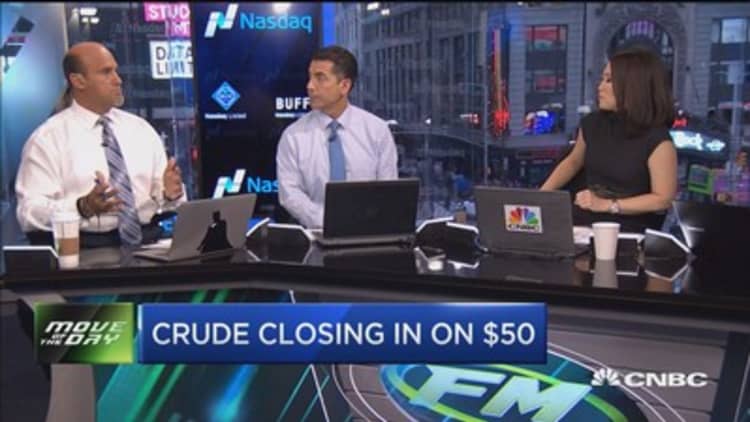
U.S. crude settled above $50 for the first time since June on Thursday, underpinned by news of another informal OPEC meeting on output cuts and a surprise drop in stockpiles.
Trading, however, was choppy after a price gain of 15 percent in seven sessions.
Oil has gained more than $6 a barrel since the Organization of the Petroleum Exporting Countries announced at informal talks in Algeria on Sept. 28 that it hopes to reduce output to 32.5 million to 33 million barrels per day. That would remove about 700,000 bpd from a global glut estimated by analysts at 1 million to 1.5 million bpd.
Brent crude futures rose 68 cents, or 1.3 percent, to $52.54 per barrel at 2:39 p.m. ET (1839 GMT), slightly off the day's peak of $52.65 and not far from the 2016 high of $52.86 set on June 9.
U.S. crude futures settled up 61 cents, or 1.2 percent, at $50.44 a barrel, the best closing level since June 9. It rose to a session peak of $50.58 on Thursday.

Earlier in the session, the market pared gains after traders cited energy monitoring service Genscape's report of a build of nearly 1 million barrels in stockpiles at the Cushing, Oklahoma delivery base for U.S. crude futures during the week to Oct 4.
Technically, both benchmarks have risen too much too soon, with Brent's Relative Strength Index at 69 and WTI's at 65 — just below the overbought level of 70.
"It's really crazy these markets," said Carsten Fritsch, commodities strategist for Commerzbank in Frankfurt. "Prices rise, regardless of the news flow and any dip is being seen as buying opportunity."
Oil crashed from above $100 a barrel in mid-2014 to around $26 in February this year from oversupply of up to 2 million bpd and OPEC's refusal then to cut output. But with the group changing its stance, and U.S. crude stocks down by a surprise 26 million barrels the past five weeks, prices have been on a roll.
A number of OPEC oil ministers plus Russia's energy minister set to attend an energy conference in Istanbul are expected to meet together informally although they are unlikely to make any new decisions, OPEC sources said.
"In a bullish market environment this is enough to push prices higher again," Commerzbank strategist Carsten Fritsch said. "It's 'the trend is your friend' and (talk) that Russia will attend next week's producer meeting in Istanbul."

Still, inventories are near record highs and even the prospect of a modest cut in production from the world's largest exporters might not be enough to fuel a more sustained rally, analysts said.
"Optimism on the OPEC deal and surprising storage declines pushed oil prices to the upper end of the recent trading range. Both trends are temporary and unlikely to mark the easing of the oil supply glut. We see more downside than upside from today's price levels," said Norbert Ruecker, head of commodity research at Swiss bank Julius Baer.
Traders said a decline in prices early in Thursday's session reflected weaker physical crude after top exporter Saudi Arabia cut the price of its crudes to Asia for November in a sign that the global fuel glut is persisting.
Hefty refinery maintenance in Europe, and the ensuing drop in demand for crude, has also put the physical North Sea market under pressure, forcing sellers to offer barrels of grades such as Forties at their weakest since July.
Overall, however, analysts said the market was well supported at current levels, especially because of the proposed output cut announced last week by the Organization of the Petroleum Exporting Countries (OPEC).
"We expect that Saudi will shoulder the bulk of the production cuts with a reduction of 5 percent or 0.5 million barrels per day (bpd), with other Gulf States cutting by 0.3 million bpd. With Iran, Libya and Nigeria getting a 'pass', remaining cuts will be on the shoulders of some of the less reliable members in OPEC," Bernstein Energy said in a note.
Algeria's Energy Minister Nouredine Bouterfa told local media on Thursday OPEC could cut production at its late November meeting in Vienna by another one percent more than 700,000 bpd agreed in Algiers last month, if needed.
Barring any unforeseen output disruptions, analysts did not expect prices to shoot up much further as production remains high even with an OPEC cut.
"Resilient production in the U.S. and Russia will postpone crude market rebalancing and keep the market in surplus into 2017," BMI Research said.
"With an insufficient demand response to counteract strong supply, the result is a downward revision of our 2017 Brent forecast to $55 per barrel from $57 per barrel," BMI said.
— CNBC's Tom DiChrstopher contributed to this report.

